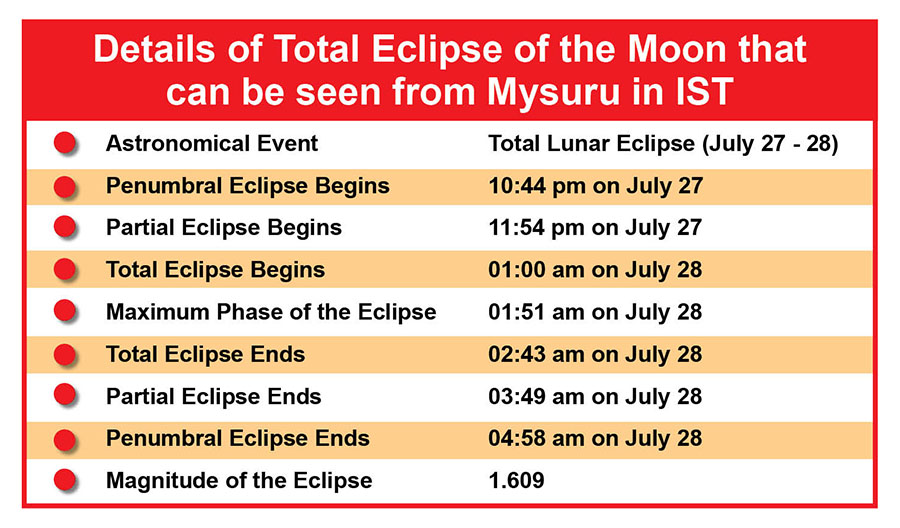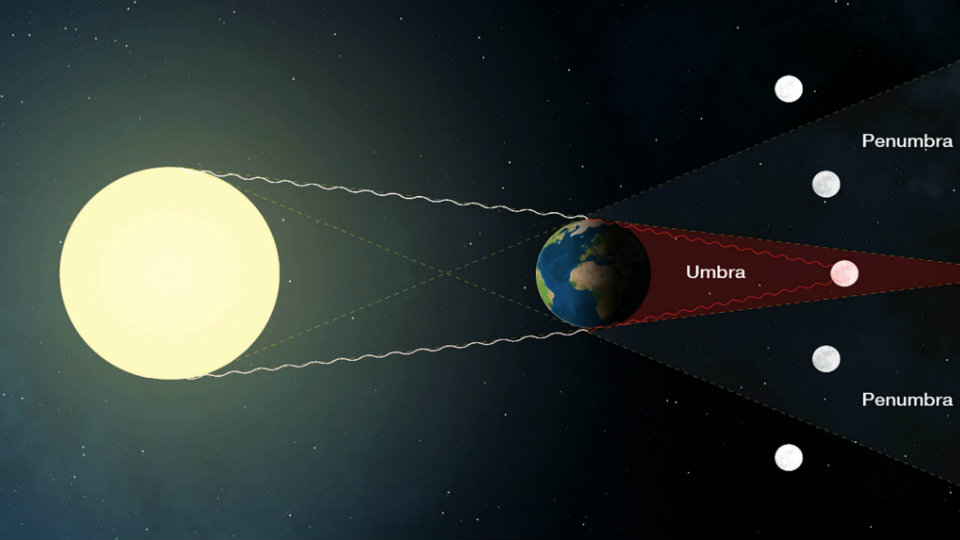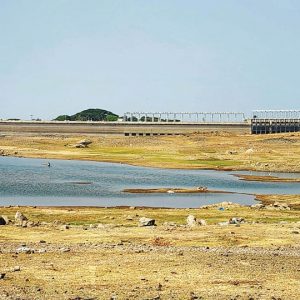By Dr. S.A. Mohan Krishna, Amateur Astronomer
None can forget the mesmerising Supermoon, Bloodmoon, Total Lunar Eclipse that occurred on January 31 this year! This astronomical occurrence was memorable and millions witnessed this spectacular spectacle. Analogously, on July 27 and 28, Indians are really privileged to witness a regular ‘Total Lunar Eclipse.’ This eclipse will be visible in the region covering Europe, Asia, Australia, Africa, Northern and Southern America, Indian, Atlantic and Pacific oceans. This eclipse can be seen from all parts of India. This Lunar Eclipse is regarded as the longest total lunar eclipse of this century with totality duration of 1 hour 43 minutes.
In simple words, Lunar Eclipse is the passage of the Moon through Earth’s shadow. Lunar Eclipses, which may be total or partial, can occur only at full moon when Sun, Earth and Moon are in line. As the Sun is an extended light source, Earth’s shadow has two components — a dark, central Umbra, where the Sun is completely obscured, and a lighter outer Penumbra, within which the obscuration is partial. During a Lunar Eclipse, the Moon passes first through the Penumbra, taking about an hour, moving eastward by its own diameter in this time, to reach the western edge of the Umbra.
During the Penumbral phase, the light of the full moon is only slightly reduced. A Lunar Eclipse occurs when the Moon passes through the Umbral region of the Earth’s shadow and becomes imperceptible. Lunar Eclipse is discernible from a large part of the Earth. Lunar Eclipses usually precede or follow Solar Eclipses by a fortnight. During a total Eclipse of the Moon, the range of shading and the intensity of colour vary enormously.
No two Lunar Eclipses are ever quite the same, and although some dismiss them as of less interest than Solar Eclipses —particularly total Solar Eclipses, where the events centred on totality occur rapidly, in contrast with more stately progress of a Lunar Eclipse — they are fascinating to observe. Lunar Eclipses also have the advantage of being visible from the entire hemisphere of the Earth where the Moon is above the horizon, rather than being most impressive along a narrow track. The main difference from one event to another is the degree to which the totally eclipsed Moon is darkened and how colourful it might be.
The complete details of Total Eclipse of the Moon that can be seen from Mysuru are given below in Indian Standard Time (IST): The duration of the Total Lunar Eclipse visible on July 27 – 28 is 6 hours 14 minutes. The total eclipse will commence at 1:00 am on July 28 and terminates by 2:43 am on July 28. The greatest phase of the eclipse will eventuate at 2:43 am on July 28. The magnitude of the total eclipse of the Moon is 1.609. On July 27, the red planet Mars will have a closer encounter with Earth, which implies that, Sun and Mars will lie opposite to each other.
Following first contact, the Moon’s more easterly limb will show a growing dark “nick” as it begins to enter the Umbra more deeply. At a Total Lunar Eclipse, Moon takes about an hour to become completely immersed in the Umbra. To begin with, there is little to see beyond a darkening of part of the Moon, but as the eclipsed portion increases, some colour may become evident. The curved edge of the Umbra may show a slight blue fringe. Refraction of sunlight — particularly at the red end of the spectrum — through Earth’s atmosphere means that the Umbra is not completely dark. Consequently, the Moon does not usually disappear from view; instead, it is dimmed and often takes on a reddish colour, which becomes increasingly apparent as the Umbral phase advances.
The diameter of Earth’s Umbra is thought by some to change in response to solar activity, perhaps decreasing at solar maximum as the upper atmosphere becomes slightly more extended in response to increased ultraviolet and X-Ray emissions. Many observers try to measure the precise extent of the Umbra during eclipses by timing the passage of its edge across identifiable Lunar features such as craters. Unless a Lunar Eclipse is very dark, it is usually quite easy to make out the dark Maria, contrasting with the brighter, cratered highlands, with the naked eye.
At totality, the Moon — completely immersed in shadow — normally shows red, orange and yellow colours, often with some gradation. Those parts of the Moon closer to the edge of the Umbra often appear somewhat brighter and more yellowish than those toward the centre, which are redder. Sunlight diffusing through the Earth’s atmosphere bathes the Moon in a dull glow that reduces it to about one ten-thousandth the normal brightness of the full Moon. The same principle causes the early-evening sky to remain relatively bright, even though the Sun is below the horizon.
The shadow’s darkness varies with the amount of cloud, dust and pollution that is suspended in the Earth’s atmosphere at the time of the Eclipse. Occasionally, the obscuration is sufficiently dense to make the Moon disappear, while at other times, the shadow imparts only a pale rusty hue to the Moon. There is absolutely no harm in witnessing this gorgeous astronomical spectacle and could be clearly witnessed by using a reflecting telescope or astral binoculars. The duration of totality in a Lunar Eclipse depends on how nearly centrally the Moon passes through the Umbra; a central passage gives a maximum of 1 hour 47 minutes. During totality, any lighter border on the Moon will appear to move gradually round from the westerly to the easterly limb. Totality ends when the Moon’s easterly limb re-emerges into sunlight, and over the next hour or so the full moon exits the Umbra to regain its usual brilliance, thereafter clearing the Penumbra.
A Total Lunar Eclipse unfolds as follows: About 20 minutes before the Moon is scheduled to enter the shadow zone, the eastern edge of the Moon becomes slightly dusky, indicating that the shadow region is nearby. However, when the edge of the Moon actually contacts the shadow, the darkening effect is unmistakable. During a total eclipse, the Moon takes about an hour to slip into the shadow. Once it is fully immersed, the Total Eclipse begins and can last anywhere from a few minutes to one and half hours. The Moon swings out of the Earth’s shadow during the final hour of the event. During the 10 minutes centred on mid-totality, try a visual estimate of the darkness of the Eclipse during a scale developed by a French Astronomer Andre Louis Danjon (1890-1967). The level of darkness is often described in terms of the Danjon Scale. This scale is intended for unaided-eye estimates: Zero on Danjon’s scale is a very dark eclipse, One is a dark grey or brownish eclipse, Two is a deep red or rust-coloured eclipse, Three is a brick-red eclipse and Four is a bright copper-red or orange eclipse. If the eclipse seems to be between two categories — One and Two, it can be recorded as 1.5 on Danjon scale. Remember, the scale is for unaided-eye estimates; binoculars or telescopes make the eclipsed Moon appear brighter.

At Mysuru, the best viewing location is from Chamundi Hill. After this year, the next time that a Blue Moon passes through Earth’s Umbra will be on Dec.31, 2028, and, after that, on Jan.31, 2037. Both of these Eclipses will be total. Before 2017, there was an 8 percent partial eclipse on Dec.31, 2009, but, for a Total Eclipse of a Blue Moon, we have to go all the way back to March 31, 1866. Large telescopes or high magnifications are of little value for observing a Lunar Eclipse. It is always recommended using binoculars or a small low-power telescope, since they both allow the entire Moon to be viewed during the event.
Next Lunar Eclipse can be seen on July 17, 2019. So, do not forget to witness the century’s longest duration Total Lunar Eclipse of this century on July 27 – 28.








The total lunar eclipse 2018 was visible in India between 1am to 2:43am on July 28 People in Kozhikode in Kerala had a good view of the lunar eclipse.Meanwhile NASA has released beautiful images of the images as seen from the Nehru planetarium in Bengaluru.
It was to be the longest lunar eclipse till 2123.The moon appeared red in colour during the lunar eclipse.
It was the longest total lunar eclipse of the century today. While the full eclipse was over 6 hours, the total lunar eclipse 2018 – when the moon will be in the middle of Earth’s shadow – lasted for 1 hour and 43 minutes. The total lunar eclipse today was the longest such eclipse for the next century, until June 9 2123. Moreover, today’s eclipse also showed the Blood Moon, a phenomenon that sees the moon take a reddish hue; this happens because the direct sunlight to moon is blocked by the Earth, the moon goes dark and only reflects the sunlight scattered by the Earth’s atmosphere. One of the best places to view the lunar eclipse 2018 is India, along with the Middle East, southern China, and eastern Africa.
The eclipse started in India at 11:44pm IST on Friday night and the total lunar eclipse 2018 is began at 1am IST. From 1:15am to 2:43am, the moon was in the middle of the Earth’s shadow and appeared reddish in colour. The eclipse continued till 4:58am though the effect was not as great.
The lunar eclipse happens when the Earth blocks the sunlight from reaching the moon.
Due to pollution, people in some metro cities in India were not able to view the eclipse in its full glory, but those in the countryside got a good view of the phenomenon. Cloudy skies, however, blocked the view of the moon altogether.